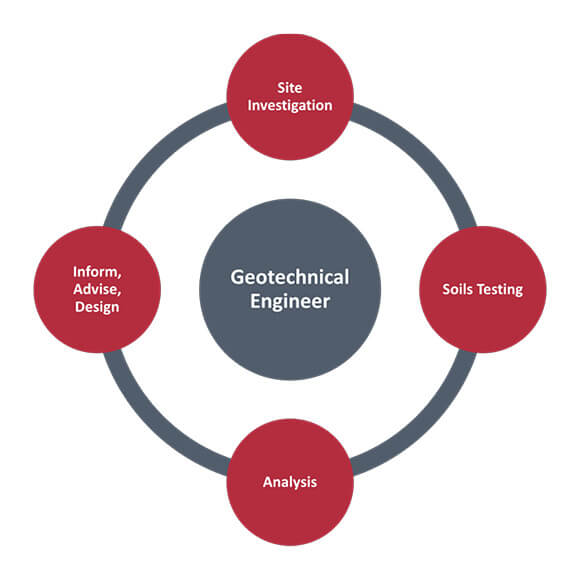The Geotheta Diaries
Table of ContentsThe Ultimate Guide To GeothetaEverything about GeothetaExcitement About GeothetaGeotheta Can Be Fun For EveryoneThe Single Strategy To Use For Geotheta

They conduct site investigations, accumulate examples, do research laboratory tests, and assess data to assess the viability of the ground for construction jobs - Geo Tech Engineer. Based upon their findings, geotechnical engineers provide referrals for foundation style, incline security, retaining structures, and mitigation of geotechnical hazards. They collaborate with various other experts, such as designers, architectural engineers, and building and construction groups, to make certain that geotechnical factors to consider are integrated right into the general task layout and application
By analyzing the behavior and properties of dirt and rock, they can identify prospective geotechnical risks such as landslides, soil negotiation, or incline instability. Their proficiency assists stop failings or accidents that might threaten lives and residential or commercial property. Below are some detailed tasks and obligations of a geotechnical engineer: Site Investigation: Geotechnical designers conduct website examinations to collect data on subsurface problems.
They translate the data to understand the residential or commercial properties and behavior of the soil and rock, including their toughness, permeability, compaction features, and groundwater conditions. Geotechnical Analysis and Style: Geotechnical designers evaluate the data collected throughout website investigations to evaluate the security and suitability of the site for building jobs. They execute geotechnical computations and modeling to evaluate variables such as birthing capacity, negotiation, slope stability, side planet pressures, and groundwater flow.
The 8-Minute Rule for Geotheta
Structure Layout: Geotechnical engineers play an important duty in making structures that can safely support the designated structure. They assess the dirt conditions and load needs to establish the proper foundation kind, such as superficial structures (e.g., grounds), deep structures (e.g (https://geotheta.wordpress.com/2024/08/02/unlocking-the-secrets-of-geotechnical-engineers-the-geotheta-advantage/)., heaps), or specialized strategies like soil enhancement. They consider aspects such as negotiation limits, bearing ability, and soil-structure interaction to develop optimal foundation designs
They evaluate construction strategies, display website activities, and conduct area evaluations to validate that the style suggestions are adhered to. If unforeseen geotechnical issues develop, they examine the situation and supply recommendations for remediation or modifications to the design. Threat Evaluation and Mitigation: Geotechnical engineers analyze geotechnical hazards and dangers connected with the task website, such as landslides, liquefaction, or soil disintegration.

Partnership and Interaction: Geotechnical engineers work closely with various other experts associated with a job, such as engineers, architectural engineers, and building groups. Reliable communication and collaboration are necessary to incorporate geotechnical considerations right into the total task layout and building procedure. Geotechnical engineers offer technical experience, solution inquiries, and ensure that geotechnical needs are fulfilled.
Geotheta - An Overview
Right here are some kinds of geotechnical engineers: Foundation Engineer: Foundation designers concentrate on designing and examining foundations for structures. They assess the dirt conditions, load requirements, and website features to establish one of the most proper foundation kind and design, such as superficial foundations, deep foundations, or specialized strategies like pile foundations.
They evaluate the variables influencing slope security, such as dirt buildings, groundwater conditions, and slope geometry, and create methods to stop slope failures and mitigate risks. Earthquake Engineer: Quake engineers concentrate on evaluating and designing structures to withstand seismic pressures. They assess the seismic threat of a site, examine soil liquefaction possibility, and develop seismic design criteria to make sure the safety and security and strength of frameworks throughout quakes.
They perform field screening, collect examples, and examine the gathered data to characterize the soil properties, geologic formations, and groundwater problems at a website. Geotechnical Instrumentation Designer: Geotechnical instrumentation designers concentrate on surveillance and gauging the habits of dirt, rock, and frameworks. They mount and preserve instrumentation systems that keep track of factors such as dirt settlement, groundwater levels, incline motions, and architectural variations to examine efficiency and offer early warnings of potential issues.
The 6-Minute Rule for Geotheta
They perform tests such as triaxial examinations, combination examinations, straight shear tests, and permeability examinations to gather information for geotechnical evaluation and design. Geosynthetics Engineer: Geosynthetics designers concentrate on the design and application of geosynthetic materials, such as geotextiles, geogrids, and geomembranes. They make use of these materials to enhance soil security, strengthen inclines, give water drainage options, and control erosion.
They often tend to be investigatory people, which suggests they're intellectual, reflective, and curious. They are curious, methodical, logical, analytical, and logical. Some of them are additionally social, suggesting they're kind, generous, participating, patient, caring, useful, empathetic, sensible, and pleasant - Engineer of Record.
In the workplace setting, geotechnical designers use specialized software program devices to do computations, produce layouts, and examine information. They prepare records, review job specifications, interact with clients and employee, and coordinate task activities. The workplace setting offers a helpful environment for study, evaluation, and cooperation with other professionals associated with the project.
The Definitive Guide for Geotheta
They often visit job websites to conduct site examinations, evaluate geotechnical problems, and collect data for analysis. These check outs entail traveling to different areas, in some cases in remote or difficult surfaces. Geotechnical engineers may carry out dirt sampling, conduct tests, and display building tasks to ensure that the geotechnical elements of the job are being executed properly.
Geotechnical engineers also work in specialized geotechnical labs. Geotechnical lab designers work thoroughly in these settings, handling testing devices, running instruments, and tape-recording data.